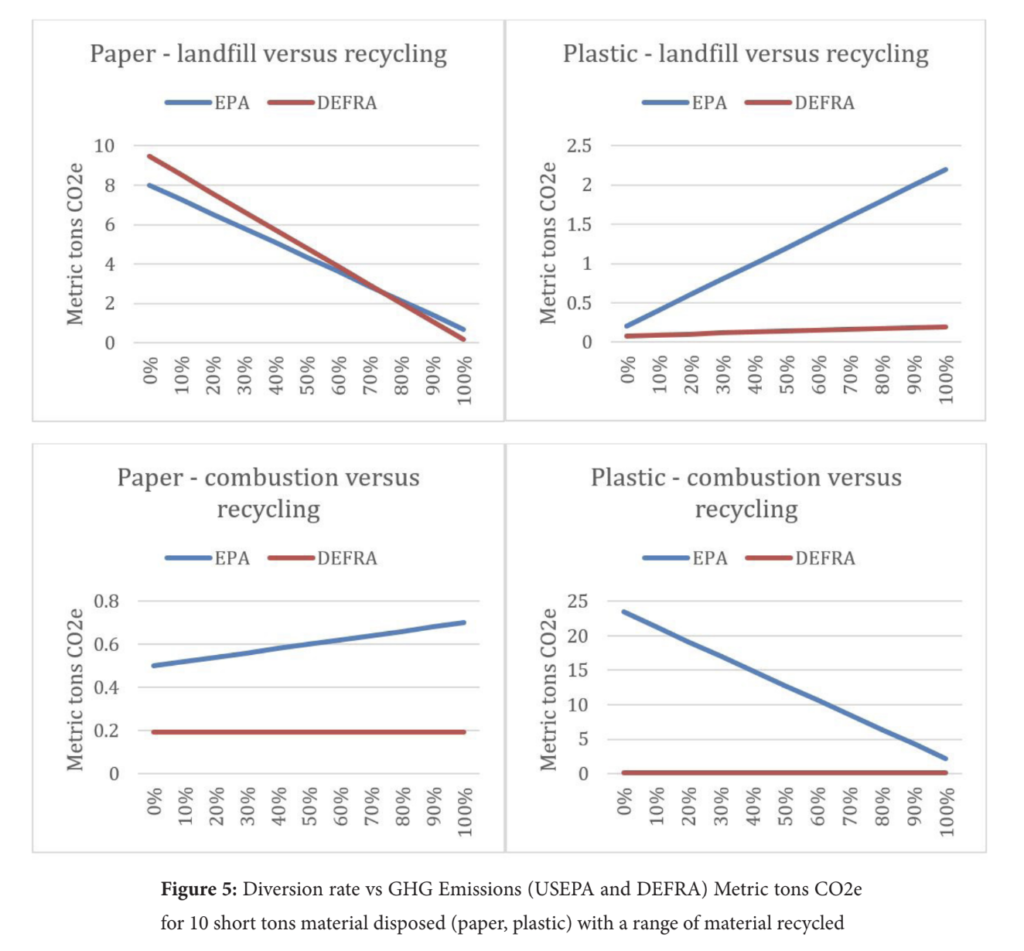
Tracking and reporting greenhouse gas (GHG) emissions is a growing priority for the corporate sector, but the current system poses GHG reporting challenges that are confounding businesses because 1) there are several methods appropriate for data collection, (2) factors vary by governmental agency, and (3) there are different models for quantifying emissions from the same agency. These complications invite reporting errors and inconsistencies.
A new study from Great Forest, published in the Journal of Waste Management and Disposal, reveals reasons for the discrepancies, illustrates the inconsistencies with a case study, and provides guidance as to what businesses can do to navigate those challenges. The paper focuses on GHG from waste, which falls under Scope 3, and usually makes up the largest portion of a businesses’ carbon footprint. Scope 3 covers all emissions produced indirectly by a business along its entire supply chain, for example, emissions from the transport of supplies and waste, or from landfill disposal.
Here is a summary of the study that explains the challenges and what businesses should do.
GHG Reporting Challenges: Lack of Global Standard
There is more than one approach to documenting scope 3 emissions from waste. The Great Forest paper compared two main sources for emissions factors: EPA (US Environmental Protection Agency) and DEFRA (UK’s Department for Environment, Food & Rural Affairs). The emission factors on waste provided by the governmental organizations of the two countries are incompatible. While our research did not examine other countries, the assumption is that differences exist worldwide.
Here’s a breakdown of US EPA vs. UK DEFRA Inconsistencies:
- EPA’s approach includes emissions from the transport and the recycling process, which more accurately describes the impact, instead of just including emissions from transport as DEFRA does, but it exposes businesses to potential double counting. For example, the purchase and use of recycled materials would double count emissions of sending materials to be recycled.
- EPA vs. DEFRA is akin in a way to Celsius v Fahrenheit. Both describe temperature but based off different inputs. You cannot combine data from DEFRA emission factors with data based off of EPA Factors Hub just like you can’t combine the degrees used in Celsius with Fahrenheit.
- We found that similar inputs to each methodology result in differing GHG results for recycling, composting and incineration processes.
- The results show that increasing diversion through recycling does not always correlate to decreasing GHG emissions calculations. The results were dependent on the material being recycled and the alternative waste management process: landfill or incineration. (See graphs below.)
Additional Issues To Note
- Scope 3 relies on third-party information. There is a need for consistency so that third-party data is replicable, and we have a consensus on what the numbers represent.
- The ‘standard’ EPA emissions factors should not be confused with EPA’s Waste Reduction Model (WARM), which is a comparative modeling system that utilizes a broader lifecycle approach that includes avoided emissions. However, avoided emissions are not to be included in, or deducted from, the company’s inventory. This is a potential source of confusion for reporting organizations.
What Can Businesses Do About GHG Reporting Challenges?
Without a global standard governing GHG calculations and data collection, GHG data will provide an inaccurate and inconsistent picture of carbon footprint accounting. This not only makes it difficult to define waste’s climate impact and the effectiveness of corporate Zero Waste programs, but it also affects business planning and decision making, ESG ratings, and other sustainability and climate change efforts, and might lead to greenwashing. Here is what businesses can do to navigate the challenges:
-
Understand the inconsistencies:
Businesses need to rely on available emissions guidance from the government. Until a standard is put in place, businesses must understand that there is more than one approach to documenting scope 3 emissions from waste, and that there are different methods of data collection, and disparities in emissions factors.
-
Report data in a way that best reflects your organization:
While the GHG Protocol, which guides corporate reporting, is clear about the boundary of Scope 3 Category 5 for reporting and the options available, it is up to organizations to provide consistency in collecting and reporting data in a way that best reflects the organization’s waste management activities. The aim is for transparency. Providing details, like a lifecycle analysis of materials and avoided emissions, shows specificity to the company, its activities and programs, as well as projections for the future based on these activities, providing the most complete picture of an organization’s waste management activities and their climate impact.
-
Aim for accuracy with waste audits:
In reporting its GHG emissions resulting from waste to organizations like CDP (via the GHG protocol), Great Forest recommends companies do the following to make the process as accurate as possible:
-
- For waste data collection, there are several methods companies may use to calculate emissions from waste generated in their operations, but managed by third parties. With any method it is important to conduct a waste audit to either verify reporting from haulers or appropriately sort waste by type.
- For emissions factors, employ the waste emissions factors in the EPA Factors Hub or local guidance that shows a complete view of Scope 3 emissions from waste, including both transportation and processing of the waste generated by a business.
- For reporting, calculate emissions based on these emissions factors. Waste management decisions should be made using the EPA’s WARM model because it uses a life cycle analysis that includes avoided emissions. However, avoided emissions are not to be included in, or deducted from, the company’s reporting inventory.
Learn more:
Read the full paper, including the case study: Greenhouse Gas Emissions from Waste: A Critique on the Data Inconsistencies for Reporting and Decision Making
Need help? Contact info@greatforest.com
Photo: Jas Min, Unsplash


